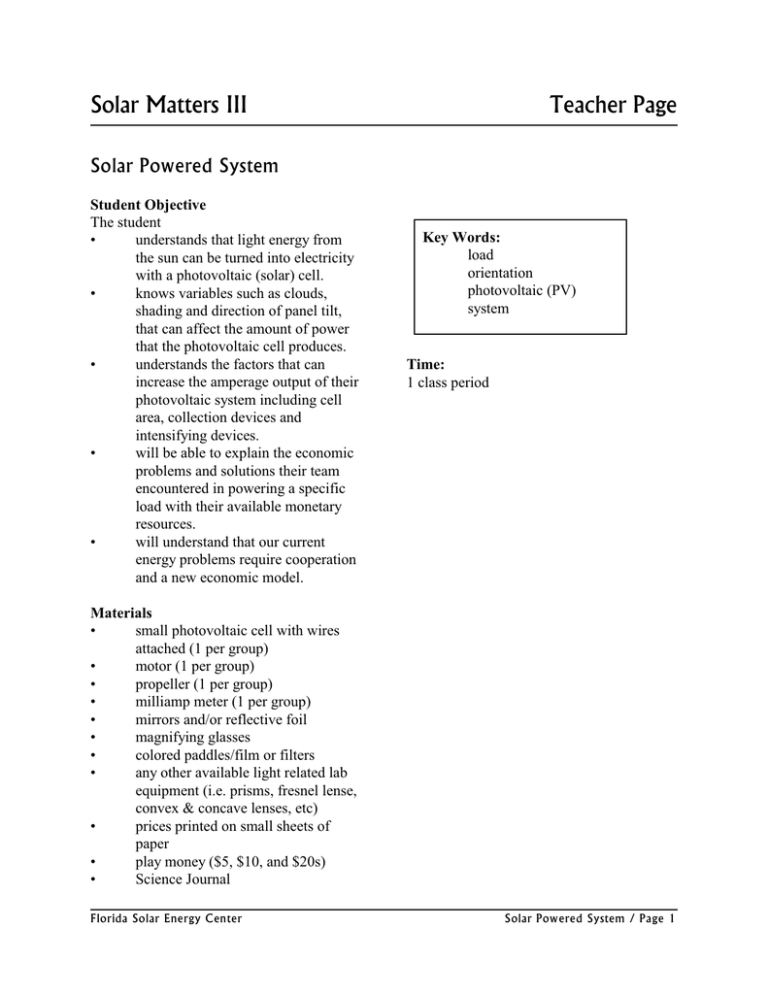Solar Matters III Teacher Page Solar Powered System
advertisement

Solar Matters III Teacher Page Solar Powered System Student Objective The student • understands that light energy from the sun can be turned into electricity with a photovoltaic (solar) cell. • knows variables such as clouds, shading and direction of panel tilt, that can affect the amount of power that the photovoltaic cell produces. • understands the factors that can increase the amperage output of their photovoltaic system including cell area, collection devices and intensifying devices. • will be able to explain the economic problems and solutions their team encountered in powering a specific load with their available monetary resources. • will understand that our current energy problems require cooperation and a new economic model. Key Words: load orientation photovoltaic (PV) system Time: 1 class period Materials • small photovoltaic cell with wires attached (1 per group) • motor (1 per group) • propeller (1 per group) • milliamp meter (1 per group) • mirrors and/or reflective foil • magnifying glasses • colored paddles/film or filters • any other available light related lab equipment (i.e. prisms, fresnel lense, convex & concave lenses, etc) • prices printed on small sheets of paper • play money ($5, $10, and $20s) • Science Journal Florida Solar Energy Center Solar Powered System / Page 1 Background Information Photovoltaic cells (called PV or solar cells) are made of silicon (sand). The silicon is heated to extreme temperatures. It is doped (coated/mixed) with chemicals, usually boron and phosphorous. This sets up an unstable environment within the photovoltaic cell. When light strikes the cell, electrons are dislodged and travel along wires placed within the cell. The electrons follow the wire and power whatever load is attached, in this case a motor. This flow of electrons is called electricity. PV cells use sunlight to produce electricity. Photovoltaic systems are quiet, clean, and non-polluting. Procedure 1. Discuss what a photovoltaic (PV – ‘solar’) cell is made of and how it works. 2. Give each team of students a photovoltaic cell, motor and propeller. 3. Demonstrate how to attach the propeller to the motor. Have the students attach their propeller. 4. Demonstrate how to attach the cell wires to the motor wires – red to red, black to black. Have the students attach their wires. 5. Demonstrate the holding position of the system (i.e. face up, directed towards the sun), making sure that the wire connections do not touch each other. 6. Demonstrate how they will remove the motor and attach the milliamp meter. Point out that one of the terminals on the back of the milliamp meter has a ‘+’ sign by it and should be connected to the positive (red) wire. 7. Take the “solar powered systems” outside and activate them in the sunlight. 8. While outside, discuss results and suggest things for the teams to try. Points to cover could include: • What happens when the panel is turned over away from the light? • What happens when part of the panel is shaded with your hand? How much of the panel can you shade before the motor stops? • Observe the rotation of the propeller blades, which way are they turning? What happens when the wires are attached the opposite way (red to black)? • Does the angle of the cell in relation to the sun make a difference in how fast the propeller turns? • What happens when the two alligator clips touch? 9. Have the students attach the milliamp meter and see how much amperage their cell is producing. 10. Have the students return to their seats (retaining their equipment) and read them the following challenge activity: Power Up and $ave “You are all members of a quaint community in Florida named Sun Town. Sun Town has one movie theater that serves the entire population. The movie theater has huge electric bills especially in the summer when people like to escape from the heat. Unfortunately, the movie theater may have to close if they can't find a solution to their high electricity bill. You have been grouped into teams based on the neighborhoods in Sun Town. Each Florida Solar Energy Center Solar Powered System / Page 2 neighborhood (team) has been asked to come up with ideas on how to power the movie theater using solar energy. Each of the neighborhood teams will be given $20 to use towards testing and implementing their plan of action. The goal is to create 500 milliamps of sustained reliable renewable power. By producing 500 milliamps you have successfully powered the movie theater. Because you are responsible citizens you are trying to spend the least amount of the $20 as possible, while accomplishing the goal of 500 sustained milliamps. There are no rules except, no cheating or stealing. A store has been set up with additional materials that you can use to help you put together your system. Additionally, any item can be returned or exchanged, so you can continue to try out different combinations. Remember, you want to have as much money left over as possible while still getting your milliamp meter to read 500 mA.” 11. Turn the groups loose and help with the store as necessary. (Don’t tell them, but since there is only one movie theater that they are all trying to power, the most effective way to power it and have the most money left over would be for all the teams to pool their money and use it for the least expensive solution they can find.) Your store should have items ranging from $5 pieces of aluminum foil (or mirrors) to additional small panels ($10.). It is also fun if you can have something (like a large fresnel lens) that is priced higher than what they think they can afford ($50 or 60). Remember the teams already have a panel that is worth something (usually $10) at the store. Plan accordingly. The challenge should be tough for them to attain with their $20 but not necessarily impossible. Some possible store items and prices: Mirrors, pieces of aluminum foil $5. Pairs of wires with alligator clips $5. Magnifying glass* and other lenses $5. Color filters* $5. Hand warmers* $5. Black construction paper* $5. Small PV cells $10. Medium sized PV cells $20. 3V PV panels $20. Fresnel lens $50. * these are ‘confounding’ items–they don’t increase the output of the photovoltaics, and can actually decrease the output 12. 13. 14. Give the students ample time to try different solutions. You may want to remind them after a few minutes that there is only one movie theater. (However, they may still not catch on. Don’t tell them!) After returning to the classroom, ask the groups to tell you the different ways they were able to attain 500 mA, and how much money they had left over. If the students did not think to team up, ask them what would have happened if they would have all worked together to solve the problem of their shared movie theater. (This is a great time to discuss how our future energy problems will require cooperation between groups!) Florida Solar Energy Center Solar Powered System / Page 3 15. 16. 13. Discuss variables that can affect the output of the photovoltaic cell such as: • time of day • weather conditions • time of year • location (latitude) on earth Questions for further discussion: • How could you use a solar powered system for a flashlight which you want to use at night when the sun isn’t shining where you are? Hint: You need a device to store the electricity. (A battery) • What could we do to produce more electricity on a cloudy day? (Use more cells in the system) Have students complete the Student Journal. Key Words & Definitions • load - a device to which power is delivered, such as a motor, a light, or a household appliance • orientation - set in a definite position with reference to the points of the compass • photovoltaic (PV) - the effect of producing electric current using light ‘photo’: light ‘voltaic’: relating to electricity (volt) • - a group or combination of things or parts forming a compex or unified whole Related Research 1. How are photovoltaics used in the space program? In telecommunications? Use the internet to collect data and pictures of these applications. Are the photovoltaic cells different or the same as those used in terrestrial applications? 2. How are photovoltaic cells made? Research the difference between single crystal, poly crystal and thin film cells. Which is the cheapest to produce? Which has the highest efficiency? 3. At the present time there are more photovoltaics in use on the continent of Africa than the North American continent. Why is this so? (Hint: It has nothing to do with climate, weather or latitude) Related Reading • Solar Energy Projects for the Evil Genius by Gavin Harper (McGraw-Hill, 2007) This book includes more than 50 solar energy projects with plans, diagrams and schematics. Internet Sites http://www.eia.gov/kids/energy.cfm?page=solar_home-basics Department of Energy, Energy Kids photovoltaics page Florida Solar Energy Center Solar Powered System / Page 4 http://energy.gov/eere/energybasics/articles/photovoltaic-technology-basics Department of Energy page explains how photovoltaics work and includes a brief animation http://energyquest.ca.gov/ California Energy Commission’s interactive student page http://www.fsec.ucf.edu/en/consumer/solar_electricity/basics/index.htm Florida Solar Energy Center's photovoltaic fundamentals page explains the basics of photovoltaic cells including their manufacture, the components of systems, as well as the pros and cons of photovoltaic power. Site is suitable for teachers, mentors and advanced students. Florida Solar Energy Center Solar Powered System / Page 5 Solar Matters III Florida Next Generation Sunshine State Standards Solar Powered System .1 .2 .3 .4 .5 .6 .7 .8 .9 .10 .11 .12 Grade 6 Practice of Science #1 SC.6.N.1 # 11 SC.7.P.11 X Grade 7 Energy Transfer & Transformations X Sixth Grade Benchmarks Science–Big Idea 1: The Practice of Science • SC.6.N.1.4 - Discuss, compare, and negotiate methods used, results obtained, and explanations among groups of students conducting the same investigation. Seventh Grade Benchmarks Science–Big Idea 11: Energy Transfer and Transformations • SC.7.P.11.2 - Investigate and describe the transformation of energy from one form to another. Florida Solar Energy Center Solar Powered System / Page 6 Solar Matters III Science Journal Solar Powered System 1. In the space below, draw a diagram of a solar powered system that lights a lamp and label its parts. 2. Make a list of things in your home and classroom that could be powered with photovoltaic energy (solar electricity). Circle any of the items in your list that you already power with photovoltaics. Florida Solar Energy Center Solar Powered System / Page 7




